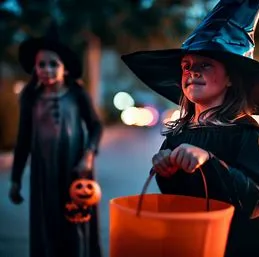🍬Unraveling the Origins of the Trick-or-Treating Tradition 🍬
Every October, as the leaves turn golden and the air grows crisp, a sense of excitement fills the air. Streets become a parade of ghosts, witches, superheroes, and mythical creatures. Porch lights illuminate, signaling a warm welcome to those in search of treats.
This is the magic of Halloween, and at its heart lies the time-honored tradition of trick-or-treating. But how did this delightful ritual, which brings joy to millions, come to be? Let's embark on a journey through time to uncover its captivating origins.
The story of trick-or-treating is a tapestry woven from threads of ancient rituals, medieval theater, religious practices, and modern cultural adaptations. From the mystic rites of the Celts to the playful guising of Scottish and Irish immigrants, and finally to the candy-filled escapades of today's children, the evolution of this tradition is as rich and varied as the costumes we see each year.
As we peel back the layers of history, we'll discover that beyond the masks and the candy lies a deeper essence. Trick-or-treating is not just about sweets; it's a celebration of community, a testament to human creativity, and a reflection of society's ever-changing dynamics. So, grab your lanterns and let's step into the enchanting world of Halloween's most cherished custom. 🎃
👻 The Ancient Echoes: Samhain
Long before Halloween as we know it, the ancient Celtic festival of Samhain was celebrated. This festival marked the end of the harvest season and was believed to be a time when the spirits of the dead returned to the world of the living. Villagers would don costumes, often made of animal skins, to ward off these spirits.
🎭 Theatrical Times: Mumming
The tradition of mumming traces its roots back to the Middle Ages, a time of chivalry, knights, and folklore. Mumming was more than just a simple act; it was a form of street theatre that brought communities together and added a touch of magic to their daily lives.
Mummers, dressed in elaborate costumes, would take on the roles of various characters from myths, legends, and sometimes even political events. These characters often included kings, queens, heroes, and villains. The stories they enacted were not just for entertainment; they were a reflection of societal values, hopes, and fears.
Going from door to door, these early performers didn't seek candy but rather sustenance and hospitality. In return for food, drink, or sometimes even small coins, they would offer a performance. These performances ranged from singing and dancing to short plays that conveyed moral lessons or recounted legendary tales.
Interestingly, while mumming is closely associated with the origins of trick-or-treating during Halloween, it wasn't exclusive to this holiday. Mummers would also make appearances during other significant festivals like Christmas and Easter. Over time, as societies evolved and urbanized, the tradition of mumming began to wane, giving way to more modern forms of entertainment. However, its spirit lives on in the trick-or-treating traditions we cherish today.
So, the next time you see children in costumes going door-to-door on Halloween, remember the mummers of old and the rich theatrical history they represent. 🎭
🙏 A Blend of Beliefs: All Soul’s Day
With the spread of Christianity, a new holiday emerged: All Soul’s Day. Celebrated on November 2nd, this day was dedicated to honoring the dead. It borrowed elements from Samhain, including masquerades. A unique tradition called souling began, where children would request treats in exchange for prayers for the departed.
🎃 Modern Makeover: Guising to Trick-or-Treating
The journey from ancient rituals to the modern-day Halloween festivities we know and love is a fascinating one. Central to this evolution is the transition from the European tradition of guising to the Americanized trick-or-treating.
Guising, a term derived from 'disguise', involved individuals, primarily children, dressing up in costumes and visiting homes. But instead of the familiar "Trick or Treat!" chant, they would offer a song, poem, or even a joke in exchange for a treat. This practice was especially prevalent in Scotland and Ireland, where it became an integral part of Halloween celebrations.
When waves of European immigrants, especially the Scottish and Irish, arrived in North America, they brought with them their rich cultural traditions, including guising. However, the new world was a melting pot of cultures, and as these traditions intermingled, they began to evolve.
In the early 20th century, Halloween in the U.S. saw a rise in mischievous and sometimes even destructive pranks. The term trick-or-treating emerged as a sort of 'ultimatum' given by children: provide a treat, or a trick (prank) might be played on the homeowner. The emphasis shifted from performance (as in guising) to this playful threat.
By the 1930s and 1940s, with community efforts to make Halloween a more child-friendly and community-centered holiday, trick-or-treating became a cornerstone of the celebration. The practice was further popularized by media, movies, and even commercial interests, as candy companies recognized the potential of this festive tradition.
Today, trick-or-treating is synonymous with Halloween in the U.S. and many other parts of the world. Children eagerly await the chance to don their costumes, explore their neighborhoods, and collect a bounty of sweets. While the practices have changed, the spirit of community, celebration, and a touch of the supernatural remains. 🌌

Sour Candy Variety Pack - Bulk

🍫 Fun Facts to Chew On:
- The two most popular Halloween candies are Snickers™ and Reese’s™ peanut butter cups.
- Approximately 35 million children in the U.S. go trick-or-treating every year.
- It's estimated that a whopping $3 billion is spent on Halloween costumes annually in North America.

Light Up Scary LED Mask with LED Glow Gloves

In conclusion, the origins of the trick-or-treating tradition are a rich tapestry of cultural practices, beliefs, and evolutions. So, the next time you don your costume and head out with your candy bucket, remember the centuries of history that have led to that moment. 🌌




